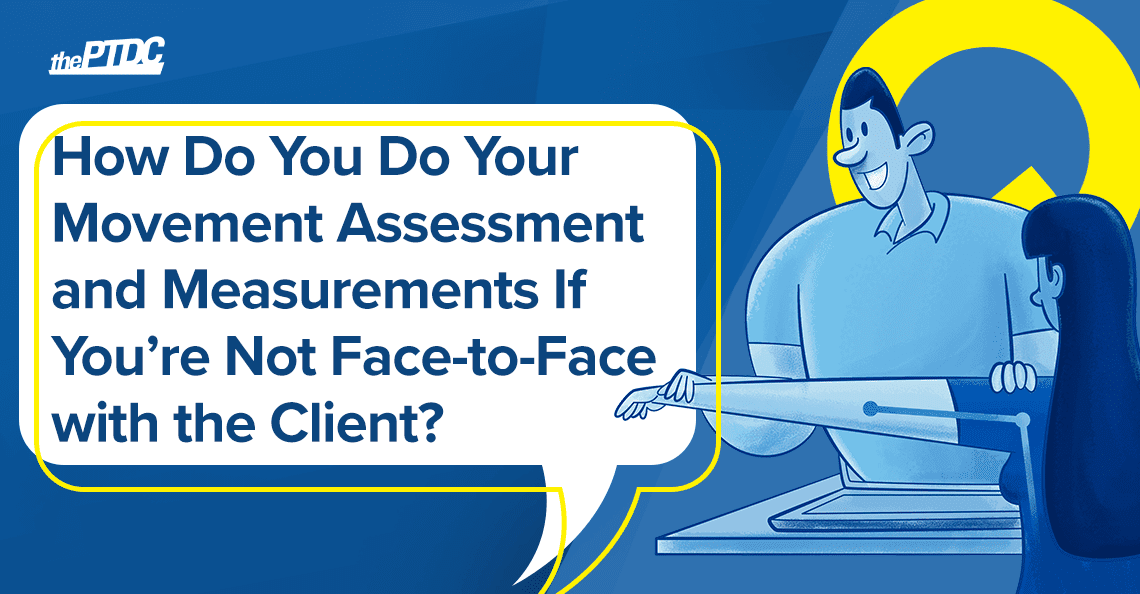 Taking on a new client typically begins with some kind of assessment to determine the person’s:
Taking on a new client typically begins with some kind of assessment to determine the person’s:
- baseline fitness level
- movement limitations
But when you train someone remotely, doing your movement assessment and measurements can be harder if you’re not face-to-face with the client.
You can’t see your client from every angle to gauge how well they move, and you’ll have to rely on the client to take their own measurements.
But that’s totally okay.
Getting the details you need to train a client effectively is much simpler than you think.
How Do You Do Your Movement Assessment and Measurements If You’re Not Face-to-Face with the Client?
You don’t need valid methods—you need reliable ones.
First, forget the notion that your assessments have to be scientifically valid to be useful. The truth is, you never know for sure if they’re valid anyway, even if you’re working with a client in person in the gym.
I’ll give you an example.
Many trainers like to use body-fat scales and analyzers to track their clients’ body fat over time. These machines rely on bioelectrical impedance analysis (BIA) to measure body comp.
BIA sends a weak electrical impulse through the different tissues and, depending on how much resistance the current meets, the computer judges what the breakdown is of lean mass to fat, water, etc. (Fat offers more resistance than muscle or water.)
That all sounds pretty sophisticated, but research has shown that BIA can be totally inaccurate.
In 2016, Consumer Reports tested six different home-use body-fat scales and compared them to the measurements of a lab machine (the Bod Pod, which is on par with hydrostatic weighing in terms of accuracy). The home-use scales were off by at least 21 percent, and as much as 34 percent.
This is why I favor reliability over validity.
You want to choose assessment methods that are simple enough for an untrained person (your client) to do at home, and that are easily repeatable, so they provide a reliable gauge of progress over time.
They may not be 100 percent accurate, and that’s okay. Unless you’re training physique athletes, you don’t need to know your client’s precise body-fat percentage—just whether it’s getting better or worse and by how much.
Two reliable weight-loss measurements if you’re not face-to-face with the client
1. Tape measure
Any kind will do, as the units on all measures are the same.
If I have a client who doesn’t have one or doesn’t want to go out and buy one, I’ll send a tape measure to them myself (they cost a couple bucks—a lot less than a BIA device).
Tell the client how and where you want them to measure. If they can’t do it themselves, they can get a friend, partner, or spouse to help.
Now you’ve got an assessment tool you can trust. For example, if the client’s waistline measurement goes down over time, you know they’re losing body fat.
2. An old-school bathroom scale
A lot of trainers don’t like their clients to weigh-in daily, as it can promote an obsession with scale numbers, but the fact is, most people will want to weigh themselves anyway to see where they’re at. It’s also a reliable measure, provided you know how to use it.
Daily weigh-ins will produce varied results. Depending on lots of factors, your client’s weight could fluctuate by a few pounds day to day.
What you’re looking for is how the weight is trending.
Two apps, Happy Scale (Apple) and Libra (Android), can do that for your client automatically: They enter their weight daily, and the app graphs it so you can see what direction it’s going despite daily fluctuations.
A better way to prevent injury than movement assessments if you’re not face-to-face with the client
You probably don’t need to bother with the complex movement screens you were taught at various certs or continuing ed classes.
Clients generally don’t understand them, find them boring, and see them as a time waste, but screens also haven’t been proven to do what they’re supposed to: predict injury risk.
A 2016 review in the British Journal of Sports Medicine concluded that, “Unfortunately, there is currently no example of a screening test for sports injuries with adequate test properties,” and that, “To date, there is no intervention study providing support for screening for injury risk.”
If you’re married to one particular battery of tests because it’s worked for you in the past, go ahead with it, but you’ll have to teach your client the movements first via video. Then, they’ll have to video themselves performing the moves so you can watch them.
It’s a bigger time investment on your part, so make sure you charge for it accordingly, and budget your screen into your training package.
But my advice is not to obsess over a client’s movement quality.
You won’t have to if you assign exercises that they can do safely, with great form, and that prepare them for activities they do in their daily life.
This means variations of basic movements:
- Squat
- Hinge
- Push
- Pull
Most clients don’t need movement assessments so much as they need:
A. to not hurt themselves, and
B. to keep training consistently.
Have them do exercises that they can handle, and they’ll be able to do both.
A better way to prevent injury than movement screens is simply to check in with the client about how they’re feeling.
Is anything in the workout causing them pain?
Is there an exercise they’re just not getting the hang of?
How sore do they feel after workouts?
This way, you’ll be able to identify a problem before it becomes one, and you’ll get much more specific feedback on how the training is going.
Learn more: Get answers to more online trainer questions.











